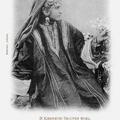Nautch Girl Lying, Jaipur
The great Hindi/Urdu writer Munshi Premchand describes, from the point-of-view of Suman, the heroine of his first novel Sevasadan, the complex view she has of Bholi, a courtesan living across the street from her:
"Suman had never met any courtesans,










